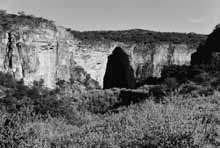Caves, Stories, History and Popular Traditions in the Semi-Desert (Sertão) of Bahia, Northeastern Brazil
DOI:
https://doi.org/10.3986/ac.v37i2-3.155Abstract
The symbiosis between man and caves usually causes a mixture of fascination and respect. When looking back at the history of Antique civilizations, there are references to this relationship made in almost all cases. Caves were men’s first home, their first meeting places, shelters, and ritualistic places. Nowadays, even with the fear of darkness and closed areas that is so usual, that old-time connection still exists. In the contemporary world, some places still hold a special sacred meaning to many social groups. Thus, the pilgrimage to Mecca in Saudi Arabia, to the shrine of Fatima in Portugal, to the Ganges River in India or to the cave church of Bom Jesus da Lapa in the interior of Bahia State, Brazil, are closely related when it comes to spiritual complicity. These sites play a key role as a collective reference of human sacrifice in an increasingly automated, technical and individualistic world much more than as strengthers of the religious faith. In Brazil there are many important religious sites. This paper mentions important sites specifically from the northeastern region. The examples are the Sanctuary of Bom Jesus da Lapa, the Cave of Patamuté, the Brejoes Cave, and the Milagrosa Cave. All these examples show clear manifestations of popular traditions and year after year illustrate the important roles that caves play in regional Brazilian societies. This paper is not intended to diminish the physical studies of karst areas but it wants to emphasize the importance of the human variable, especially in developing countries, for the relationship between karst and caves in the popular tradition, transmitted by means of oral stories and folk beliefs goes beyond the scientific advances.
Downloads

Downloads
Published
How to Cite
Issue
Section
License
Authors guarantee that the work is their own original creation and does not infringe any statutory or common-law copyright or any proprietary right of any third party. In case of claims by third parties, authors commit their self to defend the interests of the publisher, and shall cover any potential costs.
More in: Submission chapter




